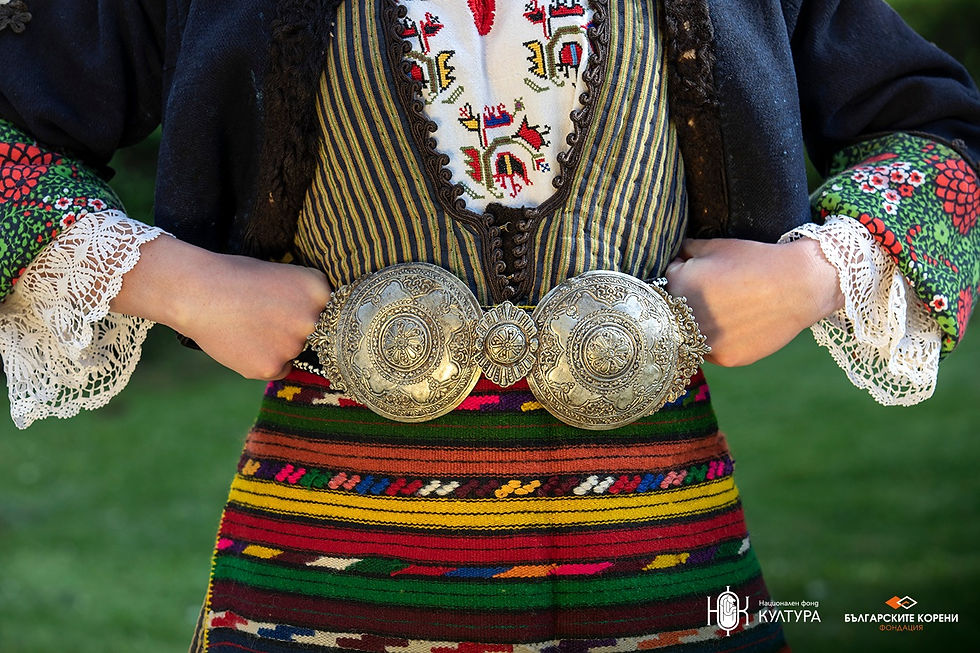„Anteriya” from Razlog with yellow and black stripes from the beginning of the 20th century
- Грозделина Георгиева-Саватинова

- Jul 8, 2021
- 3 min read
Updated: Nov 4, 2021
This is a festive costume from the late nineteenth and early twentieth century. The „zabun” and the „anteriya” are outer garments with a cut similar to the „klashnik“. They can be monochromatic or striped. They have a white, cotton, lightly quilted and taped "postava" (lining). They are worn "on ramushka", without sleeves in warm weather and at work, and sleeves are added for attire, which passes into the undergarment under the „aba”. At the bottom of the „zabun” is placed an additional piece of velvet, in a color different from the main one. If the „zabun” is considered for a local and poorer garment, then the „anteriya” is everywhere considered as a representative festive attire. It is sewn from cotton or silk fabric with multicolored stripes in Thessaloniki or Serres. It is wider and outstretched by the “zabun”, often with added long sleeves with upturned lids. The two parts of the garment are gathered in front, and the curved deep bosom is accentuated with sewn braided decoration.

Beneath it is a white shirt decorated with the "triple stitch" and "zapeski" on the bosom, the red color of which is ensemble-connected with the added red ribbon at the skirts of the yellow-black „anteriya”. The sleeves of the „koshulya” are also decorated with "zapeski" and wide knitted lace, so that it can be seen under the covers of the „anteriya”.

The features of an outer garment with an open bosom and sleevelessness require the shirt to be richly decorated, and the red color, perceived as apotropaic in folk culture, protects the wearer of the garment from "all the evil" that may befall her. Over time, these signs lose their meaning and this is perceived mainly as decoration.

In very cold weather, the woman from Razlog wore a „kontosh” from blue “shayak” with long sleeves, lined with sheepskin and wrapped in black braid. She wore various aprons on her clothes, but the most festive was "futa-badame", worn with „zabun”, „anteriya”, klashnik. Above is a velvet belt with beaded decoration, fastened with silver wrought, round buckles, which shows us that the suit is for a young married woman.

The legs are shod with „kondurki” on chairs (heels), and up with brown socks with rich decoration on the ankles, heels and toes. To give a finished look to the festive costume typical of the early twentieth century, the head is veiled with a "kushak-sindzhirliya" in yellow, and the ends can be freely released or raised and tied on top of the head.

Katerina Atanasova from Razlog put on the costume.
The costume is from the fund of the Historical Museum - Razlog.
The project "Study of the specifics and richness of national costumes from the Razlog region in the light of cultural diversity" is realized with the financial support of the National Culture Fund under the program "Cultural Heritage".
In fulfillment of the goals of the project we present some of the most beautiful traditional costumes, typical for the Razlog valley in the last 2 centuries.
We offer our sincere thanks to our hosts from the Historical Museum - Razlog, and to all local people who helped with the realization.
Special thanks to all participants and team members who took their time and with useful information, knowledge and valuable advice made possible the work on the project.
A reverence to the girls and boys from the town of Razlog, who stood in front of our camera and with their enthusiasm, youth and beauty revived for a new life the most beautiful costumes from old Mehomiya.
























Comments